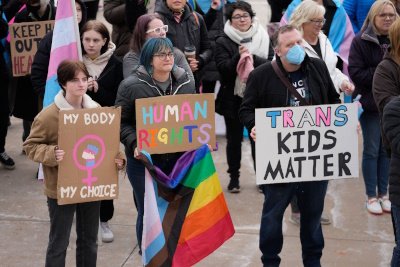
The latest obsession of Christian Nationalists is gender-affirming care and banning it for everyone, children and adults. More than 500 proposed anti LGBTQA+ laws were introduced in the states in 2023 with more than two-thirds directed at banning gender-affirming care.
People opposed to gender-affirming care use made up definitions, false or misleading information, and irrational moral panic to justify their beliefs. If you plan to oppose gender-affirming care, we would like you to at least base your opposition in reality and use actual evidence.
This FAQ is meant to explain what gender-affirming care is and what it isn’t and how the entire process works. The Secular Humanists of Western Lake Erie don’t believe that gender-affirming care should be a subject of debate. It is needed by those who need it and it should be available to all without interference from the state — even if people who make the laws personally don’t like it.
Laws should be created and passed that address actual issues and help people in the community not harm people, especially if the reasoning is based on outdated beliefs or irrational moral panic.
What is gender-affirming care?
Gender-affirming care is medically necessary, evidence-based care that uses a multidisciplinary approach to help a person transition from their assigned gender – the one the person was designated at birth – to their affirmed gender – the gender by which one wants to be known.
It is not mutilation, castration, or self-harm. Care is provided under a doctor’s care, usually more than one, along with supportive parents if the person under care is a legal minor.
Gender-affirming care starts with a social transition where the child changes their pronouns or even their name. They may wear clothing that fits the gender by which they want to be known. Unless they are emancipated the child would still need parental consent to do more than social transition. Social transitions are entirely to benefit the person making the transition. It doesn’t harm other people. Using the name or pronouns the Trans person wishes you to use is no different than using particular desired names for other people — a William wishing to be called “Bill” or a tall girl wanting to be called “Stretch” for example.
Around the start of puberty, the child may want to use puberty blockers to give them time in the gender they want to be known. Puberty blockers are safe and effective and have been used for decades. The effects are also reversible so if the child decides to go through the puberty of their gender at birth they can. Any long term effects are rare and not to be worried about.
At about 15 or 16, after the blockers, if the child is still confident they wish to continue to transition and the medical team agree, then the child can start taking hormones for the gender they wish to move to. Even after taking courses of hormones, if the child changes their mind the effects are reversible by taking the opposite hormones.
It is then around the age of 18 or 19 when the person is now able to make their own choices, they can consent to gender reassignment surgery. All the previous treatments have led up to this final step to transition. Once surgery takes place the person will fully be the gender they wish to be.
Christian nationalists have made a big deal about adults who transition and now have regrets. Yes some adults who fully transitioned may have changed their mind. The big thing to understand is the surgery part is the end of the process and is the part least likely to be reversed. Only 1 or 2% regret transitioning and de-transition. Transgender youth who meet criteria for gender dysphoria and who undergo social or medical transition are actually the least likely to de-transition. No one is forced to continue the process if they decide they don’t want to continue.
The process of transitioning takes several years and is managed by medical experts and they won’t allow the next step to happen unless they feel the person is ready. Evidence-based standards of care exist to ensure that no one, regardless of their age, undergoes any permanent, irreversible changes without informed consent and careful consultation with medical and mental health care providers.
Isn’t gender-affirming care experimental?
Major professional medical associations support gender-affirming care and have issued statements similar to this one from the Pediatric Endocrine Society:
“Medical intervention for transgender youth and adults (including puberty suppression, hormone therapy and medically indicated surgery) is effective, relatively safe (when appropriately monitored), and has been established as the standard of care. Federal and private insurers should cover such interventions as prescribed by a physician as well as the appropriate medical screenings that are recommended for all body tissues that a person may have.”
Virtually all major insurance companies recognize that transgender-related medical care is medically necessary and have a written policy describing their criteria for when plans they administer will cover it. It depends on your individual policy if such treatment is actually covered.
27 states cover gender-affirming care under their Medicaid plans.
But people from the Manhattan Institute say….
The Manhattan Institute is a right-wing think-tank. It is not a medical organization, it is political so anything they say about gender-affirming care is clouded with their right-wing conservative bias. The consensus of the actual medical community is Gender-affirming care is medically necessary, evidence-based care. Much of the arguments supporting Ohio’s House Bill 68 came from the Manhattan Institute so it is suspect and not medically or scientifically accurate.
References used:
Get the Facts on Gender-Affirming Care — Human Rights Campaign
What is gender-affirming care? Your questions answered
What the Science Says About Trans Teens on Puberty Blockers (CW: Self-Harm)
Gender incongruence and transgender health in the ICD
Gender-affirming care, a ‘crucial’ process for thousands of young people in America
